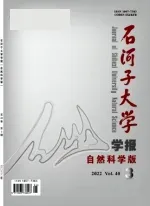响应曲面法优化酸/盐催化玉米芯产糖的工艺
姜玉柳,龚晓武,呼肖娜,周娜
(石河子大学化学化工学院/新疆兵团化工绿色过程重点实验室,石河子 832003)
我国是农业大国,玉米是三大粮食作物之一。据统计,每年玉米总产量在1.1-1.3亿t,可以副产玉米芯约0.4亿t左右[1]。目前,绝大部分玉米芯被作为农家燃料烧掉,造成很大浪费。玉米芯中的主要成分包括纤维素、半纤维素和木质素等,其中纤维素和半纤维素的含量约占70%-80%。纤维素和半纤
由图5可以看出:(1)玉米芯原料的表面较为光滑,纹理清晰可见,纤维素束紧密排列在一起,无定形的半纤维素镶嵌在其中(图5a)。(2)在H2SO4/Fe2(SO4)3中水解后,无定形的半纤维素基本消失,纤维素的结构也受到破坏,原有整齐、紧密的长链结构被打乱、切断,结构变得松散,表面还出现了一些小孔(图5b)。表明通过在H2SO4/Fe2(SO4)3中的预处理,可以将大部分半纤维素和纤维素水解生成可发酵糖。
3 结论
(1)单独采用H2SO4或Fe2(SO4)3催化玉米芯水解产糖时,总糖产率均低于40%;而将H2SO4、Fe2(SO4)3混合后催化玉米芯水解时,两者交互作用显著,总糖产率高于在2种单催化剂中水解的总糖产率之和。
(2)建立了 H2SO4浓度、Fe2(SO4)3浓度、反应温度和反应时间影响总糖产率的数学模型,得到H2SO4/Fe2(SO4)3催化玉米芯水解的最佳工艺条件为:H2SO4浓度为 0.7 mol/L,Fe2(SO4)3浓度为 2.0 mol/L,反应温度为150℃,时间为47 min,总糖产率最高,为79.98%。另外,验证实验结果与模型方程的预测值非常接近,表明预测模型在本实验的研究范围内合理、有效。
(3)上述结论为玉米芯的高值化利用提供应用研究的依据。
[1] 谢楠,齐崴,苏荣欣,等.酸水解法分离玉米芯中五碳糖和六碳糖的动力学[J].化学反应工程与工艺,2013,29(2):181-187.XIE Nan,QIWei,SU Rongxin,et al.Kinetics of dilute acid hydrolysis of corn cob for pentose and hexose separation[J].Chemical Reaction Engineering and Technology,2013,29(2):181-187.
[2]Bak J S,Ko J K,Han Y H,et al.Improved enzymatic hydrolysis yield of rice straw using electron beam irradiation pretreatment[J].Bioresource Technology,2009,100(3):1285-1290.
[3]Binder J B,Raines R T.Fermentable sugars by chemical hydrolysis of biomass[J].PNAS,2010,107(10):4516-4521.
[4]Onwudili J A.Influence of reaction conditions on the composition of liquid products from two-stage catalytic hydrothermal processing of lignin[J].Bioresource Technology,2015,187:60-69.
[5] 曲音波.木质纤维素降解酶与生物炼制[M].北京:化学工业出版社,2011:6-15.
[6]Uppugundla N,Sousa L C,Chundawat S P S,et al.A comparative study of ethanol production using dilute acid,ionic liquid and AFEX pretreated corn stover[J].Biotechnology for Biofuels,2014,7:72-85.
[7]Jeevan P,Nelson R,Rena A E.Optimization studies on acid hydrolysis of corn cob hemicelluosic hydrolysate for microbial production of xylitol[J].Journal of Microbiology and Biotechnology Research,2011,1(4):114-123.
[8]Wang X,Liu X,Wang G.Two-stage hydrolysis of invasive algal feedstock for ethanol fermentation[J].Journal of Integrative Plant Biology,2011,53(3):246-252.
[9]Amarasekara A S,Ebede C C.Zinc chloride mediated degradation of cellulose at 200°C and identification of the products[J].Bioresource Technology,2009,100(21):5301-5304.
[10]Kawamoto H,Yamamoto D,Saka S.Influence of neutral inorganic chlorides on primary and secondary char formation from cellulose[J].Journal of Wood Science,2008,54(3):242-246.
[11]Liu L,Sun J,Li M,et al.Enhanced enzymatic hydrolysis and structural features of corn stover by FeCl3pretreatment[J].Bioresource Technology,2009,100(23):5853-5858.
[12]Nguyen Q A,Tucker M P.Dilute acid/metal salt hydrolysis of lignocellulosics:United States,6423145[P].2002-07-23.
[13]颜涌捷,任铮伟.纤维素连续催化水解研究[J].太阳能学报,1999,20(1):55-58.YAN Yongjie,REN Zhengwei.Continuous catalytic hydrolysis of cellulose[J].Acta Energiae Solaris Sinica,1999,20(1):55-58.
[14]Zhou N,Zhang Y,Wu X,et al.Hydrolysis of Chlorella biomass for fermentable sugars in the presence of HCl and MgCl2[J].Bioresource Technology,2011,102(21):10158-10161.
[15]宋安东,任天宝,张玲玲,等.玉米秸秆分批补料获得高还原糖浓度酶解液的条件优化[J].生物工程学报,2011,27(3):393-397.SONG Andong,REN Tianbao,ZHANG Lingling,et al.Optimization of corn stover hydrolysis by fed-batch process[J].Chinese Journal of Biotechnology,2011,27(3):393-397.
[16]Tang X,Zhong W,Zhuang D,et al.Bagasse wet-stored with the hypochlorite bleaching waste water[J].Applied Mechanics and Materials,2013,295-298:198-201.

